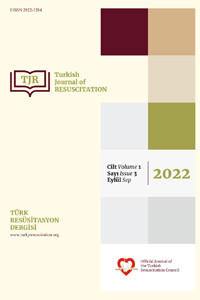Abstract
Kardiyak arrest sonrası spontan dolaşımı geri dönen (SDGD) hastalarda, mortaliteyi ve morbiditeyi öncelikli olarak nörolojik sağ kalım belirlemektedir.
Resüsitasyon sonrası bakımın kanıtlanmış en önemli nöroprotektif tedavi stratejilerinin başında ise literatürde "Targeted Temperature Management (TTM)" olarak geçen hedeflenmiş sıcaklık yönetimi gelmektedir.
HDKA ve Ventriküler fibrilasyon (VF) nedeniyle yoğun bakımımızda resüsitasyon sonrası bakımın bütün basamaklarını uyguladığımız ve rehabilitasyon sürecinin önemine dikkat çektiğimiz olguyu sunmayı amaçladık.
References
- McNally B, Robb R, Mehta M, Vellano K, Valderrama AL, Yoon PW, et al. Out of hospital cardiac arrest surveillance. Cardiac Arrest Registry to Enhance Survival (CARES), United States, October 1, 2005. December 31, 2010. MMWR Surveill Summ 2011;60:1-19
- Bernard, S. A., Gray, T. W., Buist, M. D., Jones, B. M., Silvester, W., Gutteridge, G., & Smith, K. (2002). Treatment of comatose survivors of outof-hospital cardiac arrest with induced hypothermia. New England journal of medicine, 346(8), 557-563. [3] Hypothermia after Cardiac Arrest Study Group. (2002). Mild therapeutic hypothermia to improve the neurologic outcome after cardiac arrest. New England Journal of Medicine, 346(8), 549-556.
- J.P. Nolan, R.W. Neumar, C. Adrie, et al. Post-cardiac arrest syndrome: epidemiology, pathophysiology, treatment, and prognostication. A Scientific Statement from the International Liaison Committee on Resuscitation; the American Heart Association Emergency Cardiovascular Care Committee; the Council on Cardiovascular Surgery and Anesthesia; the Council on Cardiopulmonary, Perioperative, and Critical Care; the Council on Clinical Cardiology; the Council on Stroke Resuscitation, 79 (2008), pp. 350-37
- J.M. Larsen, J. Ravkilde Acute coronary angiography in patients resuscitated from out-of-hospital cardiac arrest – a systematic review and meta-analysis. Resuscitation, 83 (2012), pp. 1427-1433
- https://doi.org/10.1016/j.resuscitation.2021.02.012
- Hollenbeck RD. Resuscitation. 2014;85:88–95, Mooney MR, Circulation. 2011;124:206–214.
- Chen H, Wu F, Yang P, Shao J, Chen Q, Zheng R. A metaanalysis of the effects of therapeutic hypothermia in adult patients with traumatic brain injury. Crit Care 2019; 23(1):396.
- Scarpino M, Lolli F, Lanzo G, et al. Neurophysiology and neuroimaging accurately predict poor neurological outcome within 24 hours after cardiac arrest: The ProNeCA prospective multicentre prognostication study. Resuscitation. 2019;143:115-123. doi:10.1016/j.resuscitation.2019.07.032
- Geri G, Dumas F, Bonnetain F, et al. Predictors of long-term functional outcome and health-related quality of life after out-of-hospital cardiac arrest. Resuscitation. 2017;113:77-82. doi:10.1016/j.resuscitation.2017.01.028
Abstract
Neurological survival primarily determines mortality and morbidity in patients with return of spontaneous circulation (ROSC).
Targeted Temperature Management (TTM) is seen as the leading proven neuroprotective treatment strategy in the literature.
We aimed to present a case in which we applied all the steps of post resuscitation care in our intensive care unit due to out of hospital cardiac arrest (OHCA) and ventricular fibrillation (VF) and drew attention to the importance of the rehabilitation process.
References
- McNally B, Robb R, Mehta M, Vellano K, Valderrama AL, Yoon PW, et al. Out of hospital cardiac arrest surveillance. Cardiac Arrest Registry to Enhance Survival (CARES), United States, October 1, 2005. December 31, 2010. MMWR Surveill Summ 2011;60:1-19
- Bernard, S. A., Gray, T. W., Buist, M. D., Jones, B. M., Silvester, W., Gutteridge, G., & Smith, K. (2002). Treatment of comatose survivors of outof-hospital cardiac arrest with induced hypothermia. New England journal of medicine, 346(8), 557-563. [3] Hypothermia after Cardiac Arrest Study Group. (2002). Mild therapeutic hypothermia to improve the neurologic outcome after cardiac arrest. New England Journal of Medicine, 346(8), 549-556.
- J.P. Nolan, R.W. Neumar, C. Adrie, et al. Post-cardiac arrest syndrome: epidemiology, pathophysiology, treatment, and prognostication. A Scientific Statement from the International Liaison Committee on Resuscitation; the American Heart Association Emergency Cardiovascular Care Committee; the Council on Cardiovascular Surgery and Anesthesia; the Council on Cardiopulmonary, Perioperative, and Critical Care; the Council on Clinical Cardiology; the Council on Stroke Resuscitation, 79 (2008), pp. 350-37
- J.M. Larsen, J. Ravkilde Acute coronary angiography in patients resuscitated from out-of-hospital cardiac arrest – a systematic review and meta-analysis. Resuscitation, 83 (2012), pp. 1427-1433
- https://doi.org/10.1016/j.resuscitation.2021.02.012
- Hollenbeck RD. Resuscitation. 2014;85:88–95, Mooney MR, Circulation. 2011;124:206–214.
- Chen H, Wu F, Yang P, Shao J, Chen Q, Zheng R. A metaanalysis of the effects of therapeutic hypothermia in adult patients with traumatic brain injury. Crit Care 2019; 23(1):396.
- Scarpino M, Lolli F, Lanzo G, et al. Neurophysiology and neuroimaging accurately predict poor neurological outcome within 24 hours after cardiac arrest: The ProNeCA prospective multicentre prognostication study. Resuscitation. 2019;143:115-123. doi:10.1016/j.resuscitation.2019.07.032
- Geri G, Dumas F, Bonnetain F, et al. Predictors of long-term functional outcome and health-related quality of life after out-of-hospital cardiac arrest. Resuscitation. 2017;113:77-82. doi:10.1016/j.resuscitation.2017.01.028
Details
| Primary Language | Turkish |
|---|---|
| Subjects | Emergency Medicine, Intensive Care |
| Journal Section | Case Reports |
| Authors | |
| Publication Date | December 29, 2022 |
| Published in Issue | Year 2022 Volume: 1 Issue: 3 |

